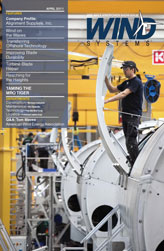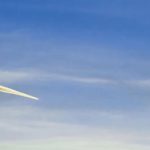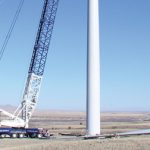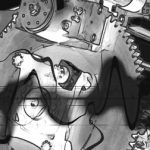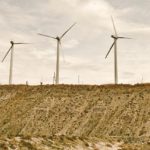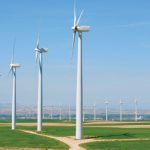Wind energy is one of the fastest growing industries in the world, with widespread growth and rapid expansion signaling a promising future. In fact, the World Wind Energy Association (WWEA) states that the wind energy market achieved approximately 16 gigawatts of new capacity worldwide added in just the first half of 2010 alone! The total capacity of all wind turbines installed worldwide reached 175 gigawatts in mid-2010, compared with 159 gigawatts by the end of 2009. This means that wind power is becoming one of the largest sources of new electricity generation, and as the market grows so does the need for fall protection equipment for its workers.
In fact, WWEA forecasts that the wind energy industry is expected to employ one million people by the year 2012. More workers on the job site means that fall protection manufacturers must keep up with the unique challenges this industry demands, and harnesses, lanyards, climbing systems, and rescue systems must be designed to meet global requirements for fall protection equipment used during tower construction, maintenance, and rescue situations. Figure 1
With turbine manufacturers sending wind teams all around the world, buying and maintaining several sets of fall protection equipment to meet several different countries’ safety standards is expensive, time-consuming, and inconvenient. The new trend in fall protection equipment for the wind energy industry is globalization, and it’s clearly here to stay. Turbine manufacturers are looking into globalized items so that workers can travel anywhere in the world without having to swap sets of fall protection equipment, reducing both costs and transportation hassle. It’s imperative that workers have versatile equipment of high quality that meets international safety standards wherever possible.
Therefore, fall protection equipment manufacturers must take all of the international safety standards into consideration when developing new products and updating existing products. The main standards to comply with are ANSI, OSHA, CE, CSA, and AS-NZS. These five standards are encountered 99 percent of the time, so equipment meeting these standards will cover nearly all bases. The differing international safety standards evolved with each country, creating an individualized code that worked for them. Unlike some industries, however, the wind industry is so global by nature that having products that can be used all over the world is key.
In addition to developing new fall protection products that meet all of these main standards, manufacturers are also retooling existing harnesses and lanyards to be globally certified. By redeveloping previous products so they are applicable around the world, fall protection manufacturers can better meet the needs of turbine manufacturers and offer solutions that deliver multifaceted benefits for their workers. Thus, harnesses, lanyards, climbing systems, and rescue systems are being tailored to comply with all major international standards.
As mentioned, with the industry growing so quickly and more workers “up in the air,” fall protection is as important as ever. Wind turbine installation and maintenance call for tight safety measures. Crews performing work at extreme heights (the tallest towers reach more than 500 feet) need to be aware of fall hazards and be provided with the most advanced fall protection equipment. Despite the high-risk tasks specific to the industry, the appropriate training and equipment can help save lives in the event of a fall. There are three situations where fall protection equipment is needed in the wind energy sector: installation, maintenance, and rescue.
Installation: From the Ground Up
When constructing wind turbines, typically a ladder safety system consisting of a ladder and vertical fall arrest system components will be installed on the inside surface of the tower. The vertical fall arrest system spans the length of the ladder and can include a stainless or galvanized steel cable or aluminum or stainless steel rail. The worker wears a full-body harness and is connected to the system by a shuttle or sleeve that follows his path up and down the ladder. In the event the worker falls, a brake in the shuttle will engage to arrest the fall.
After the tower has been erected, work on the nacelle begins. A nacelle is the structure that houses all of the generating components, such as the gearbox, at the top of the tower. This work includes the installation of electrical control unites that require cabling to be installed throughout the length of the tower, and this can be done using a service lift or ladder. When using a service lift, a full-body harness connected to a lanyard and tied off to the lift should be worn. When working from a ladder, a work positioning device or restraint should be used to allow the worker to use both hands, in addition to the fall arrest system. Figure 2
Next, the rotor will be attached to the nacelle, and in order to accomplish this workers will need to be inside the open nacelle. The ideal method is to use built-in anchorage points for the connection of a self-retracting lifeline or shock-absorbing lanyard. Prior to beginning work one end of the lanyard or SRL should be attached to the anchorage point, and the other to the dorsal D-ring of the worker’s harness. SRLs and twin-leg lanyards have the benefit of offering 100 percent tie-off during this process. This way, the worker can keep one leg of the lanyard connected to the initial anchor point while the other leg connects to the next point when the worker needs to switch anchorage points. Tie-off adapters are another method of anchorage on the nacelle, which can be wrapped around the structure to create an anchor point. Also, self-contained vacuum anchors operate with compressed air to provide a secure anchorage point on flat surfaces. Vacuum anchors can be placed anywhere on the structure where there is a flat and solid surface and easily transported. Whichever method is used, it is crucial that the anchorage point is rated for fall arrest.
Maintenance: Risky Business
It’s no secret that wind turbine maintenance work can be extremely risky. For example, accessing the blades and the hub of blades from outside the nacelle is dangerous but necessary to maintain and repair the control mechanisms of the blades and the blades themselves. Fall protection safety equipment will be similar to that needed during installation, but there are a few additional considerations to point out. Specialty permanent anchorages, specialty access equipment, and rope access techniques can all be employed to assist with routine maintenance work. Common activities like cleaning turbine blades, replacing electrical control units in the nacelle, and ensuring that the turbine is operating correctly should all be navigated with fall protection and safety at the top of one’s mind.
Rescue: Have a Plan
Working at such great heights is cause for extra preparation in case of a fall. If an accident were to occur near the top of a tower, rescue can be nearly impossible from the ground using conventional rescue tactics. Wind farms are normally located in rural areas where traditional emergency crews could be unable to respond in a timely fashion. Also, the emergency services crew may lack the appropriate equipment to assist, which is why site-specific equipment and trained personnel must be available at all times.
When evacuation is necessary self-rescue, personal evacuation, and casualty evacuation equipment should all be available to get workers down safely. The turbine should also be equipped with self-rescue and casualty evacuation equipment inside the nacelle, available for multiple users in the event of an emergency. It’s critical to keep in mind that during a rescue situation, time is always of the essence. That is precisely why a rescue plan and training also needs to be in place, especially in the event of a fire or a total mechanical failure. The rescue plan should always be developed before beginning work on any tower. The plan should outline all possible scenarios and hazards that could occur during installation and maintenance. All rescue and evacuation equipment should be easy to use and quick to deploy. Figure 3
In addition to having a thorough rescue plan, workers must be thoroughly familiar with the tactics and trained on how to execute the actions of the plan. The ideal training program consists of hands-on participation and classroom time. Any training must incorporate how to identify hazards, create fall protection programs and choose the proper equipment in the event of a rescue situation. Major topics that should be covered in training include: fall protection and rescue system assessments; applicable industry standards related to fall protection and rescue; fall hazard elimination and control methods; fall hazard surveys and procedures; development and implementation of fall protection and rescue plans and programs; proper selection, inspection, use and maintenance of fall protection and rescue equipment; and rescue procedures.
Summary: Great Heights
As the wind energy industry continues to grow and thrive, more and more employees will spend their days working at great heights. This is why fall protection equipment is more important than ever to protect those “up in the air” as they install and maintain wind turbines. The world keeps watching as more towers pop up along the horizon and more power is generated. Fall protection manufacturers are responding to this trend and constantly developing and redeveloping equipment to meet global standards, changing industry needs and worker preferences. Indeed, the future of the wind energy industry is rising to great heights.



















